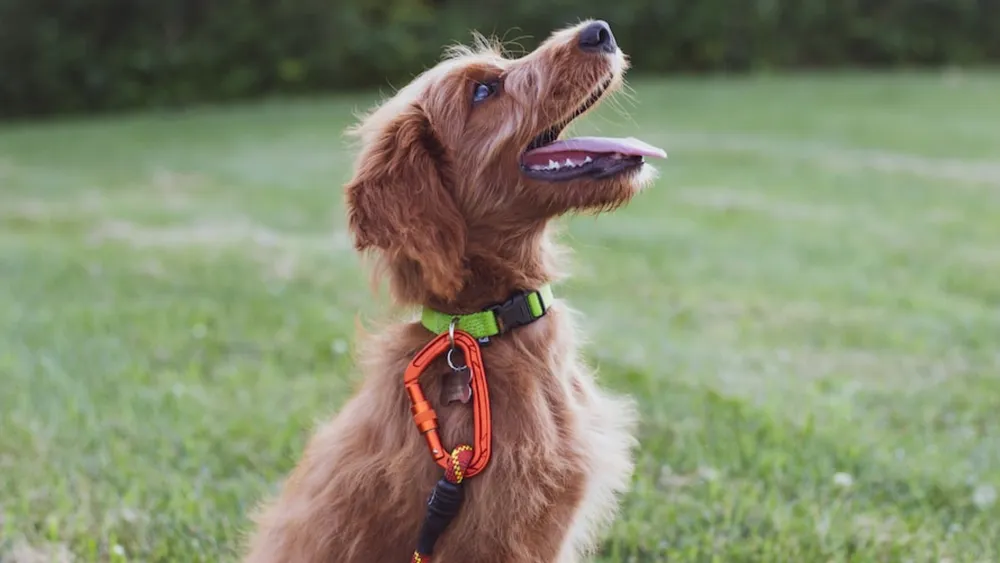Vibrating dog collars, often misunderstood and sometimes controversial, are emerging as a progressive tool in the realm of canine training and behavior modification. Unlike their more contentious counterpart, the shock collar, vibrating collars employ a gentler approach, using vibration as a means of communication and correction. This technology offers a humane alternative to traditional training methods, particularly beneficial for sensitive or hearing-impaired dogs.

The purpose of this comprehensive guide is to demystify the concept of vibrating dog collars. We will delve into their functionality, benefits, and the correct way to integrate them into your dog’s training regimen. From selecting the right collar for your furry companion to addressing common misconceptions, this article aims to provide a thorough understanding of how vibrating dog collars can enhance training and positively influence canine behavior, thereby fostering a stronger bond between you and your pet.
Understanding Vibrating Dog Collars
Vibrating dog collars are a type of training tool that utilize a gentle vibrating sensation to guide or correct a dog’s behavior. Unlike shock collars, which deliver an electric stimulus, vibrating collars produce a harmless vibration to grab the dog's attention or deter undesirable actions. This method is considered more humane and less invasive, making it a preferred choice for many dog owners and trainers.
Mechanism of Vibrating Collars
These collars are equipped with a small device that emits a vibrating sensation when activated. They are often controlled remotely, allowing the trainer or owner to administer the vibration at the appropriate moment to reinforce commands or discourage unwanted behavior. The intensity of the vibration can usually be adjusted to suit the sensitivity of the dog, ensuring the experience is effective yet not distressing.
Comparison with Shock Collars and Traditional Methods
Unlike shock collars, vibrating collars do not cause pain or discomfort to the dog, making them a more ethical and compassionate training aid. Traditional training methods often rely on verbal commands and physical cues, which can be less effective with certain dogs, especially those with hearing impairments. Vibrating collars offer an alternative means of communication that can complement these traditional methods, providing a consistent and clear signal to the dog.
Types and Variations in the Market
The market offers a range of vibrating dog collars, each designed to cater to different needs. They vary in terms of range, vibration intensity levels, battery life, and additional features like waterproofing and GPS tracking. Some collars are specifically designed for small breeds or for dogs with certain behavioral issues, ensuring that there is a suitable option for almost every dog and training requirement.
In summary, vibrating dog collars present a humane, effective, and versatile tool for dog training, providing an alternative to more invasive methods and catering to a wide range of training needs and dog breeds.
Benefits of Vibrating Dog Collars
Vibrating dog collars have gained popularity as a humane and effective training tool, offering significant advantages over traditional and more invasive training methods. Their benefits extend across various aspects of canine training and behavior management, making them a valuable tool for dog owners and trainers.
1. Effective and Humane Training Tool
- Gentle Guidance: Vibrating collars provide a non-intrusive method to communicate with your dog. The gentle vibration is enough to capture the dog's attention without causing fear or pain, fostering a positive training environment.
- Immediate Feedback: These collars allow for instantaneous correction or reinforcement, which is crucial in effective training. Dogs learn best from immediate feedback, and vibrating collars provide a way to deliver this in a way that is both clear and humane.
- Adjustable Intensity: The ability to adjust the intensity of the vibration means that it can be customized to the dog’s sensitivity level, ensuring the training experience is not only effective but also respectful of the dog's comfort and well-being.

2. Suitability for Sensitive or Hearing-Impaired Dogs
- Alternative Communication Method: For dogs with hearing impairments or those who are unresponsive to traditional auditory cues, vibrating collars offer an alternative way to communicate. The tactile sensation of the vibration serves as an effective signal for commands or corrections.
- Stress-Free Training: These collars are particularly beneficial for sensitive dogs that may become anxious or stressed by harsher training methods. The gentle nature of the vibration helps maintain a calm and positive training environment.
3. Versatility in Addressing Different Behavioral Issues
- Wide Range of Applications: Vibrating collars can be used to address a variety of behavioral issues, from basic obedience training to more complex problems like excessive barking, jumping, or boundary training.
- Customizable for Individual Needs: Different dogs respond to training techniques in different ways. Vibrating collars provide the flexibility to tailor the training approach to the individual dog’s learning style and behavioral needs.
- Complementary to Other Training Methods: These collars can be used in conjunction with other training tools and techniques, making them a versatile addition to any training regimen.
Vibrating dog collars stand out as a versatile, effective, and humane training tool. Their suitability for a wide range of dogs, including those with special needs like hearing impairments, and their ability to address various behavioral issues, make them a valuable asset for both novice and experienced dog owners seeking a compassionate approach to training.
How Vibrating Collars Aid in Training
Vibrating dog collars have become a revolutionary tool in modern dog training, utilizing gentle vibrations to aid in effective communication and behavior modification. Understanding how these collars function in the training process reveals their potential in overcoming common training challenges.
Training Process Using Vibrations
- Attention and Cue Reinforcement: The primary function of vibrating collars is to capture the dog’s attention. When a dog is distracted or not responding to verbal commands, the vibration acts as a non-verbal cue, redirecting their focus to the trainer.
- Association and Conditioning: Training with a vibrating collar involves associating the vibration with specific commands or behaviors. Initially, the vibration is used simultaneously with a command. Over time, dogs begin to understand that the vibration itself is a cue to perform a certain action or stop an undesired behavior.
- Consistency and Timing: Key to the effectiveness of vibrating collars is consistent and timely use. Correct timing ensures that the dog associates the vibration with the specific behavior being addressed, leading to quicker learning.

Case Studies and Expert Opinions
- Behavioral Modification Success: Case studies have shown success in using vibrating collars for various training challenges, such as reducing excessive barking, preventing counter-surfing, and reinforcing recall commands.
- Expert Endorsement: Many professional dog trainers endorse vibrating collars as a humane training tool. They emphasize its effectiveness, especially for dogs that are less responsive to other forms of training or have special needs, like hearing impairments.
Addressing Common Training Challenges
- Distractibility: Vibrating collars are particularly useful for dogs that are easily distracted in busy environments. The vibration serves as a focused cue that cuts through other distractions.
- Fear and Anxiety Responses: For dogs that react negatively to loud noises or harsh commands, the gentle vibration can be a stress-free way to communicate.
- Complex Commands: In advanced training, vibrations can be used to teach complex commands and behaviors by breaking them down into simpler steps, each associated with a specific vibration pattern.
Vibrating dog collars are an innovative tool that can effectively address a range of training challenges. Through proper use and understanding of their function in the training process, these collars can enhance communication between dogs and their owners, leading to improved behavior and strengthened bonds.
Choosing the Right Collar: Key Considerations
Selecting the appropriate collar for your dog is crucial in ensuring the effectiveness of the training and the comfort of your pet. When navigating the plethora of options available, several factors should guide your decision.
1. Size, Breed, and Temperament Considerations
- Size and Breed: The collar size should correspond to your dog's size and breed. Larger breeds might require collars with more robust vibration capabilities, while smaller breeds need gentler, less intense settings.
- Temperament: Understanding your dog’s temperament is key. A more sensitive dog might respond better to a collar with a range of adjustable settings to find the optimal level of vibration for effective communication.
2. Essential Features in a Vibrating Collar
- Adjustability: Look for collars with adjustable vibration levels. This feature allows for customization according to your dog’s response and tolerance.
- Comfort: The collar should fit comfortably around your dog's neck without causing irritation or discomfort. A comfortable dog is more receptive to training.
- Durability: Given the active nature of dogs, a durable collar that withstands wear and tear is essential, especially for outdoor training sessions.
Special Mention: Fi Dog Collar for Comprehensive Canine Management
While not a vibrating training device, the Fi dog collar deserves mention for its comprehensive features in canine management. This collar, equipped with GPS tracking and activity monitoring, complements training efforts by ensuring your dog's safety and well-being. It's particularly useful in managing dogs prone to escaping or wandering, providing an added layer of security during and after training sessions.

Recommendations for Different Dog Profiles
- Active and Large Breeds: Opt for a sturdy, adjustable vibrating collar with a wide range of intensities.
- Small or Sensitive Breeds: Choose a collar with gentle vibration settings and a comfortable fit.
- Dogs with Special Needs: For escape-prone dogs, a combination of a vibrating collar for training and a Fi dog collar for tracking and activity monitoring can be an ideal setup.
When choosing the right collar, consider your dog’s physical attributes and temperament, prioritize comfort and adjustability, and explore additional tools like the Fi dog collar for a holistic approach to your dog’s training and safety.
Safety and Comfort for Your Dog
When integrating a vibrating dog collar into your training regimen, prioritizing your dog’s safety and comfort is paramount. Proper use of the collar is essential to ensure it serves as a beneficial training tool rather than a source of stress or discomfort.

Ensuring Proper Fit
- Correct Sizing: The collar should fit snugly around your dog's neck without being too tight. There should be enough room to comfortably fit two fingers between the collar and your dog’s neck.
- Adjustable Fit: Choose a collar that offers adjustable sizing to get the perfect fit, especially important as your dog grows or if their weight fluctuates.
Adjusting Vibration Intensity
- Start at the Lowest Setting: Begin with the lowest vibration setting and observe your dog's reaction. The goal is to capture their attention, not to startle or scare them.
- Gradual Increase: If necessary, gradually increase the intensity until you find a level that is effective for your dog’s training while still being comfortable for them.
Watching for Signs of Discomfort or Stress
- Physical Signs: Look for signs like excessive scratching around the collar area, which could indicate discomfort.
- Behavioral Changes: Be alert to changes in behavior, such as increased anxiety or fearfulness, which may suggest the collar is causing stress.
- Adjustments: If you notice any signs of discomfort or stress, adjust the fit or intensity of the collar. Consult a professional trainer or veterinarian if you're unsure about the appropriate settings.
Ensuring the safety and comfort of your dog while using a vibrating collar is crucial for a positive and effective training experience. Regularly check the fit and monitor your dog's reaction to the collar to maintain a humane and effective training process.
Expert Insights and Additional Tips
Experts in dog training emphasize the importance of pairing vibrating collars with positive reinforcement. It's crucial to reward your dog with treats, praise, or playtime when they respond correctly to the collar's vibration. This association fosters a positive learning environment and encourages good behavior.
Additionally, it's recommended to use the vibrating collar as part of a comprehensive training strategy. Don't rely solely on the collar for training; instead, use it as a supplementary tool alongside voice commands and hand signals. This approach ensures that your dog remains responsive to various forms of communication.
Lastly, consistency is key. Maintain regular training sessions and use the collar consistently in terms of commands and vibration patterns. This consistency helps your dog understand and adapt to the training more effectively.
Conclusion:
Vibrating dog collars present a humane and effective alternative for training and managing canine behavior. These collars, when used correctly, can significantly aid in communication with your pet, especially for dogs with special needs or those unresponsive to traditional training methods. It's important to select the right collar based on your dog's size, breed, and temperament, ensuring both safety and comfort.
Remember, these collars are best used as part of a broader, positive reinforcement-based training strategy. Responsible and informed use of vibrating collars can lead to a more harmonious and understanding relationship between you and your furry companion.
FAQs
- Are vibrating dog collars safe to use on all dogs?
- Yes, when used correctly, vibrating collars are safe for most dogs. They are a humane alternative to shock collars and suitable for various breeds and sizes. However, it's important to consider the individual dog's temperament and health condition.
- How does a vibrating dog collar differ from a shock collar?
- A vibrating collar uses a harmless vibration to get the dog's attention, whereas a shock collar delivers an electric shock. Vibrating collars are considered more humane and less stressful for dogs.
- Can vibrating collars help with training deaf or hearing-impaired dogs?
- Absolutely. Vibrating collars are an effective training tool for deaf or hearing-impaired dogs, providing a tactile signal that can be used to communicate commands and cues.
- How long does it take for a dog to respond to a vibrating collar?
- The response time can vary depending on the dog’s temperament and the consistency of training. Some dogs may respond quickly, while others may need more time to associate the vibration with commands.
- Can I leave the vibrating collar on my dog all the time?
- It's not recommended to leave the vibrating collar on constantly. The collar should only be used during training sessions and removed afterwards to prevent discomfort or irritation.
- Is it possible to overuse a vibrating dog collar?
- Yes, overusing a vibrating collar can desensitize your dog to the vibrations or cause stress. It should be used sparingly and only as part of a balanced training approach.
- Should I consult a professional before using a vibrating dog collar
- Consulting a professional dog trainer or a veterinarian can be helpful, especially if you are new to this training method or if your dog has specific behavioral issues.




